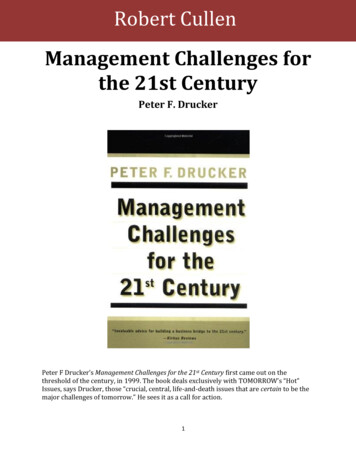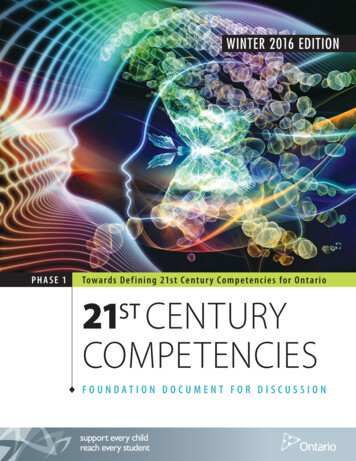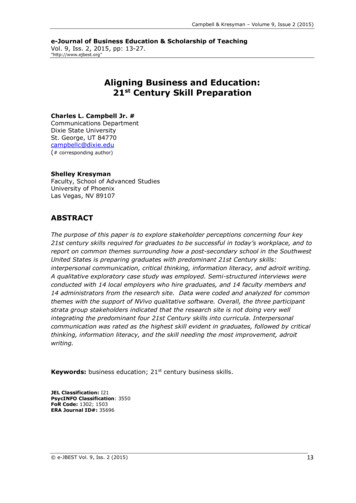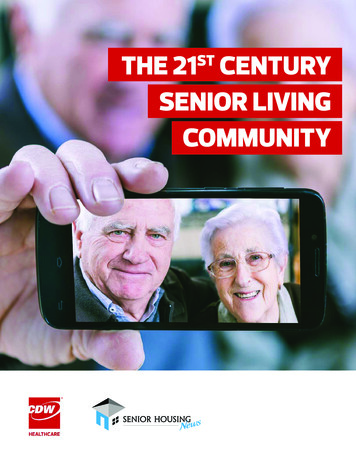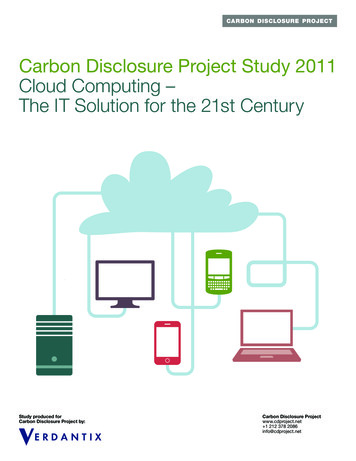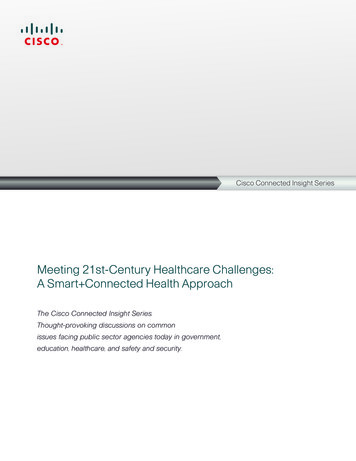
Transcription
Cisco Connected Insight SeriesMeeting 21st-Century Healthcare Challenges:A Smart Connected Health ApproachThe Cisco Connected Insight Series.Thought-provoking discussions on commonissues facing public sector agencies today in government,education, healthcare, and safety and security.
Cisco Connected Insight SeriesMeeting 21st-Century Healthcare Challenges:A Smart Connected Health ApproachContentsExecutive Summary. 2Healthcare's Challenging Environment. . 2Helping People Choose to Live Life Better. 3Smart Connected Communities. . 4The Collaboration Effect:Solutions for Improved Access, Affordability, and Quality. 5Connected Healthcare Environments. . 7Improving Responsiveness to Emergency Needs. . 8Enabling Clinical Collaboration. 8Map of Medicine. . 9Rebuilding in Post-Earthquake China. 9Current Solutions for Healthcare. 10Healthcare Technology Foundations. 10Cisco Clinical Workflow Solutions. . 10Cisco Care-at-a-Distance Solutions. . 10Connected Imaging Solutions. . 11Smart Healthcare Facility Solutions. 11Summary. . 12Acknowledgements. 121
Cisco Connected Insight SeriesExecutive Summary“To offset the wideninggap between the numberof patients and the numberof skilled staff, healthcareorganizations must increasetheir productivity while maintaining or decreasing costs.”Today’s escalating cost of healthcare is one of the world’s greatest challenges.The United States spent 2.38 trillion on healthcare in 2008, while 45.7 millioncitizens remained uninsured. From the rapidly increasing cost of healthcaredelivery, to critical staff shortages, to patient demand for more and better services, healthcare organizations are challenged to increase access to qualitycare while reducing costs. As costs continue to increase, so does the demandfor higher quality, personalized healthcare services. Given these challenges,healthcare providers must find new and different ways to deliver quality careand scale healthcare system delivery.Healthcare's Challenging EnvironmentChallenges facing healthcare organizations vary widely around the globe. In thedeveloping world, a lack of facilities, equipment, and trained personnel meanthat many people do not have convenient access to care providers or medicalfacilities. This is especially true for those in remote rural areas. In these nations,healthcare providers and governments are focused on creating a healthcareinfrastructure that will expand access and improve the quality of care availableto citizens.2
Cisco Connected Insight SeriesIn the developed world there is sophisticated healthcare infrastructure in place,but it’s not ubiquitous, and there is an increasing focus on rational consumptionof both primary and specialty services. A growing population of aging citizensstrains existing facilities and resources.“Improving staff efficiencyis an important strategy forhealthcare organizations,and many are seeking toimprove communication andcollaboration as a way tostreamline workflow.”Today's shortages of primary care and nursing providers are expected tobecome more acute in the United States as the nation’s population continues togrow and age. The U.S. Census Bureau predicts a U.S. population of 392 millionby 2050. According to the U.S. Department of Health and Human Services, therewas a 6 percent shortage of nurses in 2000. That shortage will double by 2010,resulting in a shortage of 275,000 full-time registered nurses. Although thecurrent economic climate has driven many retired nurses back into the workforce,this is viewed to be a temporary surge. By 2015, the shortage is expected tomore than triple to 20 percent and will escalate to 29 percent by 2020.At the same time, the Journal of the American Medical Association has reporteda steady decline in the number of U.S. medical student graduates choosing primary care. When combined with aging populations in developed countries, thedecline in skilled staff will quickly reach crisis levels. To offset the widening gapbetween the number of patients and the number of skilled staff, healthcare organizations must increase their productivity while maintaining or decreasing costs.In addition, as costs rise for labor, supplies, medications, medical devices, andother essentials, healthcare organizations are under increasing budget pressure.Provider pressure also exists on revenue, as organizations seek to modify reimbursements. Revenue shortfalls and rising operating costs make it difficult todeliver high-quality care and compete effectively for increasingly scarce specialistsand skilled caregivers. Hospitals and clinics are also under pressure to providethe latest medical technology, equipment, and treatment protocols to attract andretain patients. Improving staff efficiency is an important strategy for healthcareorganizations, and many are seeking to improve communication and collaboration as a way to streamline workflow.Helping People Choose to Live Life BetterThe purpose of healthcare organizations is to help people live healthy, morefulfilling, and longer lives. Cisco understands the mission as well as thecomplexity of healthcare organizations, and uses innovative technology toconnect communities and people, thereby helping people improve their lives.We call this the Human Network.3
Cisco Connected Insight Series“Members of healthcareorganizations interact withreferring physicians, outsidespecialists, patients, and patientfamilies beyond the four wallsof their hospitals. They needthe security, flexibility, andreach to execute positivecase outcomes anywhere, atany time, using a wide rangeof devices.”When technology meets humanity on the human network, the way we workchanges, and the way we live our lives changes. This is the Human NetworkEffect, and it is real. As the company that built the Internet, Cisco has deliverednetworks and networked services that help healthcare organizations connectcaregivers, patients, and staff with information and each other in new andinnovative ways.The Human Network links the world's regions, transforming communities,businesses, and lives everywhere. Our public-private partnerships havemade significant, positive strides in healthcare, education, socioeconomicdevelopment, and crisis relief. Today, Cisco touches approximately 67 percentof the world's population, or 4.6 billion people. And as that company we can offerour experience, technology, people, and reach to help healthcare organizationsuse the power of the network to address the challenges faced by healthcareproviders within the system today.Smart Connected CommunitiesWe envision that the same principles of openness that have made the Internetthrive for the past 20 years can be applied to help healthcare thrive as well.Through our global Smart Connected Communities initiative, healthcareorganizations can connect people to each other, to information, and to newdiagnostic and treatment capabilities. The Smart Connected Communitiesinitiative employs next-level infrastructure, technology, services, and platformsto create intelligent, enduring solutions for healthcare.Cisco Smart Connected solutions are based on technology and architecturesthat include: Collaboration: These solutions facilitate inclusiveness and encouragecollaborative decision-making among care teams, primary and specialistphysicians, patients and their families, and public/private partners. And theyhelp effectively harness the efforts of talented caregivers to unify the caredelivery methodology that solves problems, prevents disease, and createspositive healthcare case outcomes. Virtualization: These solutions enable resources such as information, workspaces, and expertise to be shared and dynamically delivered to applicationsand individuals on demand. Virtualization today is occurring within hospitaldata centers, IT-as-a-Service solutions, and specialized expertise.4
Cisco Connected Insight Series Borderless organizations: Today, healthcare organizations interact withreferring physicians, outside specialists, patients, and patient families beyondthe four walls of their hospitals. A "borderless network" provides the security,flexibility, and reach that enables care organizations to execute positivecase outcomes anywhere, at any time, using a wide range of devices.The Collaboration Effect:Solutions for Improved Access, Affordability, and QualityToday Cisco sees three guiding principles in our healthcare mission: weare helping healthcare organizations and providers improve access, driveaffordability, and enhance the quality of care. Cisco’s healthcare solutions forcollaboration provide: Increased caregiver teamwork and productivity to meet the challenges of anaging population and an increase in chronic disease Better patient experiences by delivering increasingly sophisticated andcostly treatments more efficiently and in new ways Patient-centered care that is safe, effective, and efficient, emphasizingprevention and health, rather than dealing only with illnessFor the future, care will not always depend on physical proximity. Patients will beable to maintain relationships with doctors who know them best, no matter wherethey live. At the same time, caregiving frequently includes participants who are notat the patient location, such as referring physicians, outside specialists, andpatient families. Increasingly it will become easier for multiple caregivers such asprimary care physicians and specialists to care for patients and their familiesat the same time.Cisco collaboration solutions can also help healthcare organizations improveinternal efficiency, enhance administrative and clinical staff productivity, andextend resources to new locations more affordably. In the 2009 Cisco NurseSurvey, 84 percent of nurses said that they spend up to 60 minutes per shiftsearching for supplies. Efficiency and productivity improvements can help reducecost pressures by freeing skilled staff for more appropriate tasks such as directadministration of medications and care.5
Cisco Connected Insight SeriesFigure 1. Excerpt from 2009 Cisco Nurse SurveyQuestion: Nurses often use mobile devices such as a smart phone, tablet PC,walkie talkie or pager, to communicate and relay information about patients.What information do you need to access on a nurse’s communication device atthe point-of-care?Information NeededPercentagePatient location and status56Care team availability and location48Patient lists (coverage)39Room availability32On-call directory29Map showing location of equipment13Other*13Not sure17*Four each: Lab results; Medication infoTwo each:Drug reference; medical records; patient statusOne each: Calendar function; reports; emergency code; home computerdatabase; physician status; plan of care; new admissions;treatment schedulenone/don’t use (10)Finally, collaboration technology can help providers and caregivers reduce theamount of time spent tracking down peers, waiting for lab results, and findingpatient information. In the 2009 Cisco Nurse Survey, 86 percent of responderssaid that chasing other people to get answers can take as long as 2 hours per shift.And 74 percent said that improved communication could have a high impact onthe patient experience. With communication and collaboration solutions, more timecan be spent with patients and improving the quality of the patient experience.6
Cisco Connected Insight SeriesConnected Healthcare Environments“The network provides thecommon element that enablesorganizations to empowercaregivers, administrators,and patients, deliver real-Several decades ago, a single physician treated all of a patient’s various illnesses.Today, a patient often receives treatment from multiple physicians at multiplelocations. This creates the need for medical and clinical information to be securelyshared among many healthcare entities. To provide the framework for this newhealthcare world, a connected healthcare ecosystem is needed. A connectedhealthcare system includes networked resources of medical information,knowledge support, and process optimization.time information, and meetthe needs of a secure, yetempowering borderlessservice model.”Technology has matured to be become a difference-maker for healthcareproviders, administrators, and patients. For many healthcare organizations,the first step in achieving a connected healthcare environment is to create anIP infrastructure that supports the rapid exchange of data between people,institutions, regions, applications. At Cisco, we believe that the network is criticalto support those advanced technologies that will meet healthcare’s mostpressing challenges. The network provides: The common element that enables organizations to empower caregivers,administrators, and patients, deliver real-time information, and meet theneeds of a secure, yet empowering borderless service model. The platform that truly integrates technology architecture with the architecture of an organization's unique mission and constituents. The ability to enable collaboration, use Web 2.0 capabilities, increaseproductivity, and deliver a personalized patient experience anytime,anywhere, on any device.7
Cisco Connected Insight SeriesThe network provides the foundation for delivering communication andcollaboration solutions that improve people-to-people connections across careteams for the greatest potential impact. Today, Cisco is putting the principlesof Smart Connected Health into practice with numerous healthcare projectsaround the globe.Improving Responsiveness to Emergency NeedsMercy Regional Medical Center (MRMC) in Durango, Colorado, ranks in the top10 percent of U.S. hospitals in a range of care processes, including delivering carefor heart attack, heart failure, and surgical site infection prevention. Until recentlyMRMC used manual procedures for locating specialists and on-call physicians.When a critical patient arrives in MRMC’s Emergency Department, on-call doctorsmay require immediate consultations with specialists, such as orthopedic surgeons and anesthesiologists. Technicians located these people using manualphone calls, pages, and paper schedules written daily by charge nurses. If thefirst doctor did not respond, they used other contact sheets to find additionalnames and phone numbers. This process took time and required a technician toleave other important tasks until an available specialist was found. Using a CiscoConnected Health solution, the hospital now locates vital on-call resources upto 50 percent faster, with significantly fewer interdepartmental calls.Enabling Clinical CollaborationKaiser Permanente Healthcare system is faced with many of the challengesdescribed above, including a nursing shortage and staff retention. To help improvethe efficiency of its healthcare teams, Kaiser implemented Cisco WebEx Meeting and Collaboration Tools and WebEx Training Center. These solutionsare used for delivering nurse training and advanced professional development,8
Cisco Connected Insight Seriesincreasing collaboration among the nursing team available to prepare nursesfor leadership. Cisco WebEx is also used by the Optical Services Group withinKaiser Permanente to improve communication with staff and patients. Thissolution reduces the amount of travel required between facilities to optimizestaff productivity and reduce costs.Map of MedicineA good example of how critical connectivity is in solving healthcare problemsis the Map of Medicine product. This is a web-based visual representation ofpatient care "pathways" that represent best practices for dealing with variousdiseases and conditions. Originally developed in cooperation with the NationalHealth Service in the United Kingdom, Map of Medicine helps drive a collaborative, evidence-based means of delivering health services.A pilot program in Kijabe, Kenya, has demonstrated its particular value inextending the reach of healthcare in the developing world by allowing healthcare workers to treat conditions otherwise beyond their ability, and by servingas an on-the-job educational resource that's equivalent to full-time access to themost up-to-date textbooks. This collaborative model is critical to the successof efforts like those in India to support the healthcare system by enhancingknowledge transfer from urban to rural regions. A further value to the developingworld is the product's ability to be regionalized tuned to deal with the diseasesor conditions endemic to a given area.The collaborative model of Map of Medicine is important in the developed worldas well. This and similar case management efforts can help move treatment awayfrom the expensive, acute-care end of the system (hospitals), to the less expensive,primary-care arena, where most healthcare happens anyway: family physicians,local clinics, elder-care facilities, physical therapy centers, and the like. In Australia,for instance, approximately 60 percent of emergency room visits are unnecessary. How much money could be saved by equipping primary-care facilities withthe knowledge needed to treat conditions that really don't require a hospital visit?The same is true for managing chronic disease and elder health: improved collaboration through efficient communications is the only way to train the healthcareworkforce rapidly enough to address these increasingly costly issues.Rebuilding in Post-Earthquake ChinaCisco is supporting rebuilding efforts in China's earthquake-affected SichuanProvince, working with public-private partnerships to help develop healthcaremodels that are supported by collaborative networked information technology andcommunications. These initiatives have been developed to help bridge the gap9
Cisco Connected Insight Seriesbetween urban and rural areas and more broadly share the best education andhealthcare resources available. These 21st century healthcare models are beingdesigned with the potential for replication and scaling in countries around theworld. As a part of Sichuan's Health 2020 initiative, Cisco is working in collaborationwith healthcare officials to develop a network of connected hospitals and healthcaresolutions. Healthcare providers will be able to collaborate across the province, withaccess to online patient health records and other key innovative solutions that willhelp deliver higher quality care.Current Solutions for HealthcareCisco Smart Connected Health solutions help healthcare organizationsaddress access, affordability, and quality issues throughout their organizations.Healthcare Technology FoundationsCisco Healthcare Technology Foundations create the framework for the CiscoMedical Grade Network (MGN). The basis for the MGN architecture is focused onredundancy, high availability, scalability and security for both wired and wirelessaccess to the network. With this foundation in place organizations can preparethemselves not only for current infrastructure requirements but also for futuresolutions down the road.The security framework embedded within MGN enables healthcare organizations to promote security best practices that meet regulatory compliance goalssuch as HIPAA, thereby improving patient care and response times, as well asoperational efficiency. Technologies included within this solution include CiscoDigital Media System, Medical Data Exchange Solution, Cisco Data Center forHealthcare, Cisco Secure Wireless, and Cisco Image Architecture.Cisco Clinical Workflow SolutionsCisco Clinical Workflow Solutions help enable patients, clinicians, administrators,and families communicate through the innovative use of data, voice, and video.By having accurate, timely information, these groups can collaborate more effectively to make better, faster decisions. Cisco Context-Aware Healthcare integrateslocation and sensor information to respond quickly to patients, coordinate andreduce over-procurement of assets, and streamline workflow. Cisco Nurse Connectintegrates nurse call systems with Cisco wireless phones, enabling nurses andpatients to communicate with each other in a quiet and secure manner regardlessof where the nurse may be on the floor. Cisco Mobile Collaboration enhancescollaboration and exchange of information at the point of care by providing secureand robust network access from tablet PCs.10
Cisco Connected Insight SeriesCisco Care-at-a-Distance SolutionsCisco Care-at-a-Distance Solutions provide a new access model for healthcare, connecting care providers and patients over distances while also directlyaddressing affordability and quality as they pertain to healthcare delivery. The newCisco HealthPresence system creates an immersive environment similar towhat most people experience when they visit their Doctor or specialist. CiscoTelePresence for Healthcare makes it easier and more convenient for cliniciansto collaborate using high definition video and audio, regardless of location.Cisco Collaboration and Reporting promotes effective, efficient imageconsul-tations with radiologists and physicians in any location. Cisco Experton Demand establishes real-time communication with on-demand audio andvideo conferencing enabling language interpretation better serving our growingand global diverse communities. Lastly, utilizing Cisco WebEx in healthcareprovides an easy-to-use collaboration tool for administrators, clinicians,technologists, and caregivers.Connected Imaging SolutionsCisco Connected Imaging combines technologies from Cisco and its healthcarepartners to deliver imaging as a service from the foundation of the Cisco MedicalGrade Network. Images are virtualized and optimized in a medical archive, makingthem available anywhere across a healthcare enterprise, significantly reducingthe overhead for extra storage in standalone imaging applications. Clinicianscan quickly access data for accelerating diagnosis and treatment. Solutionswithin the Connected Imaging suite include Cisco Medical Data Exchange,Collabo-ration and Reporting, Horizon Medical Imaging Collaboration, andImage Architecture solutions.Smart Healthcare Facility SolutionsWith Cisco Smart Healthcare Facility solutions, developers and builders canreplace disparate networks with one simplified, flexible, and scalable IP network.Unified communications converge voice, video, and data capabilities overbuilding information networks with videoconferencing, telemedicine, wirelessand remote access, and other collaboration and productivity tools. Convergingsecurity applications over the building information network allows organizationsto use their existing IP infrastructures for video surveillance, access control, visitormanagement, and fire safety.The IP infrastructure can even support the monitoring, control, and visibility ofvaried building systems, such as HVAC, lighting, transportation, and energymanagement.11
Cisco Connected Insight SeriesConverging these systems over a single information network allows healthcareorganizations to reduce operational, energy, and maintenance costs. In addition,the hospital IT group can deliver innovative services that improve caregiverproductivity and enhance patient care.SummaryAlthough healthcare organizations face a range of challenges as they strive toimprove outcomes for patients, they can look to Cisco as a partner with the reach,technology, sustainability, and concern to help. The Cisco Smart Connectedinitiative is helping many healthcare organizations meet their objectives byusing the network as a platform for next-generation communication, collaboration, and service delivery.Americas HeadquartersCisco Systems, Inc.San Jose, CAAsia Pacific HeadquartersEurope HeadquartersSystems (USA) Pte. Ltd.Cisco Systems International BVFor more information Ciscoaboutthe Cisco Smart Connectedinitiative and otherSingaporeAmsterdam, The Netherlandspublic-sector solutions, visit www.cisco.com/go/healthcare, where numerousresourcesare available.Cisco has more than 200 offices worldwide. Addresses,phone numbers,and fax numbers are listed on the Cisco Website at www.cisco.com/go/offices.CCDE, CCENT, CCSI, Cisco Eos, Cisco HealthPresence, Cisco IronPort, the Cisco logo, Cisco Lumin, Cisco Nexus, Cisco Nurse Connect, Cisco Pulse, Cisco StackPower, Cisco StadiumVision, Cisco TelePresence,Cisco Unified Computing System, Cisco WebEx, DCE, Flip Channels, Flip for Good, Flip Mino, Flipshare (Design), Flip Ultra, Flip Video, Flip Video (Design), Instant Broadband, and Welcome to the Human Network aretrademarks; Changing the Way We Work, Live, Play, and Learn, Cisco Capital, Cisco Capital (Design), Cisco:Financed (Stylized), Cisco Store, and Flip Gift Card are service marks; and Access Registrar, Aironet, AllTouch,AsyncOS, Bringing the Meeting To You, Catalyst, CCDA, CCDP, CCIE, CCIP, CCNA, CCNP, CCSP, CCVP, Cisco, the Cisco Certified Internetwork Expert logo, Cisco IOS, Cisco Press, Cisco Systems, Cisco Systems Capital, theCisco Systems logo, Cisco Unity, Collaboration Without Limitation, Continuum, EtherFast, EtherSwitch, Event Center, Explorer, Fast Step, Follow Me Browsing, FormShare, GainMaker, GigaDrive, HomeLink, iLYNX, InternetQuotient, IOS, iPhone, iQuick Study, IronPort, the IronPort logo, Laser Link, LightStream, Linksys, MediaTone, MeetingPlace, MeetingPlace Chime Sound, MGX, Networkers, Networking Academy, Network Registrar, PCNow, PIX,PowerKEY, PowerPanels, PowerTV, PowerTV (Design), PowerVu, Prisma, ProConnect, ROSA, ScriptShare, SenderBase, SMARTnet, Spectrum Expert, StackWise, The Fastest Way to Increase Your Internet Quotient, TransPath,WebEx, and the WebEx logo are registered trademarks of Cisco Systems, Inc. and/or its affiliates in the United States and certain other countries.AcknowledgementsMany people across Cisco contributed to the writing of this paper. Specifically wewould like to thank Kaveh Safavi (IBSG), Kathy English (Marketing), Erik Petersen(Marketing), and Frances Dare (IBSG) for their expertise and their collaborationacross Marketing and Cisco Field in producing this edition of "Cisco ConnectedAll other trademarks mentioned in this document or website are the property of their respective owners. The use of the word partner does not imply a partnership relationship between Cisco and any other company. (0908R)Insight” for our customers.Americas HeadquartersCisco Systems, Inc.San Jose, CAAsia Pacific HeadquartersCisco Systems (USA) Pte. Ltd.SingaporeEurope HeadquartersCisco Systems International BVAmsterdam, The NetherlandsCisco has more than 200 offices worldwide. Addresses, phone numbers, and fax numbers are listed on the Cisco Website at www.cisco.com/go/offices.CCDE, CCENT, CCSI, Cisco Eos, Cisco HealthPresence, Cisco IronPort, the Cisco logo, Cisco Lumin, Cisco Nexus, Cisco Nurse Connect, Cisco Pulse, Cisco StackPower, Cisco StadiumVision, Cisco TelePresence,Cisco Unified Computing System, Cisco WebEx, DCE, Flip Channels, Flip for Good, Flip Mino, Flipshare (Design), Flip Ultra, Flip Video, Flip Video (Design), Instant Broadband, and Welcome to the Human Network aretrademarks; Changing the Way We Work, Live, Play, and Learn, Cisco Capital, Cisco Capital (Design), Cisco:Financed (Stylized), Cisco Store, and Flip Gift Card are service marks; and Access Registrar, Aironet, AllTouch,AsyncOS, Bringing the Meeting To You, Catalyst, CCDA, CCDP, CCIE, CCIP, CCNA, CCNP, CCSP, CCVP, Cisco, the Cisco Certified Internetwork Expert logo, Cisco IOS, Cisco Press, Cisco Systems, Cisco Systems Capital, theCisco Systems logo, Cisco Unity, Collaboration Without Limitation, Continuum, EtherFast, EtherSwitch, Event Center, Explorer, Fast Step, Follow Me Browsing, FormShare, GainMaker, GigaDrive, HomeLink, iLYNX, InternetQuotient, IOS, iPhone, iQuick Study, IronPort, the IronPort logo, Laser Link, LightStream, Linksys, MediaTone, MeetingPlace, MeetingPlace Chime Sound, MGX, Networkers, Networking Academy, Network Registrar, PCNow, PIX,PowerKEY, PowerPanels, PowerTV, PowerTV (Design), PowerVu, Prisma, ProConnect, ROSA, ScriptShare, SenderBase, SMARTnet, Spectrum Expert, StackWise, The Fastest Way to Increase Your Internet Quotient, TransPath,WebEx, and the WebEx logo are registered trademarks of Cisco Systems, Inc. and/or its affiliates in the United States and certain other countries.All other trademarks mentioned in this document or website are the property of their respective owners. The use of the word partner does not imply a partnership relationship between Cisco and any other company. (0908R)DRMKT/LW16121 10/0912
Meeting 21st-Century Healthcare Challenges: A Smart Connected Health Approach The Cisco Connected Insight Series. Thought-provoking discussions on common issues facing public sector agencies today in government, education, healthcare, and safety and security. Cisco Connected Insight Series


